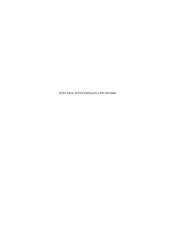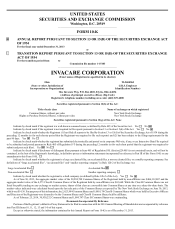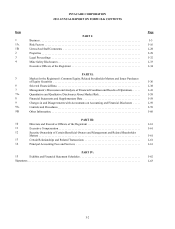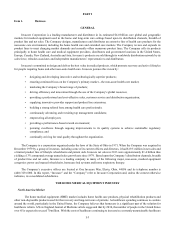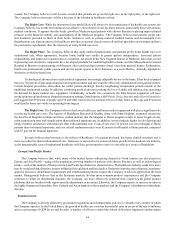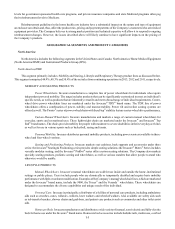Invacare 2013 Annual Report Download - page 16
Download and view the complete annual report
Please find page 16 of the 2013 Invacare annual report below. You can navigate through the pages in the report by either clicking on the pages listed below, or by using the keyword search tool below to find specific information within the annual report.I-10
Dynamic Controls, the Company's subsidiary which produces electronic components for use in power wheelchairs, scooters,
respiratory and other products, sells to customers in North America, Europe and Asia/Pacific.
PRODUCT LIABILITY COSTS
The Company is self-insured in North America for product liability exposures through its captive insurance company,
Invatection Insurance Company, which currently has a policy year that runs from September 1 to August 31 and insures annual
policy losses up to $10,000,000 per occurrence and $13,000,000 in the aggregate. The Company also has additional layers of
external insurance coverage insuring up to $75,000,000 in aggregate losses per policy year arising from individual claims anywhere
in the world that exceed the captive insurance company policy limits or the limits of the Company’s per country foreign liability
limits, as applicable. There can be no assurance that Invacare’s current insurance levels will continue to be adequate or available
at affordable rates.
Product liability reserves are recorded for individual claims based upon historical experience, industry expertise and
indications from the third-party actuary. Additional reserves, in excess of the specific individual case reserves, are provided for
incurred but not reported claims based upon actuarial valuations at the time such valuations are conducted. Historical claims
experience and other assumptions are taken into consideration to estimate the ultimate reserves. For example, the actuarial analysis
assumes that historical loss experience is an indicator of future experience, that the distribution of exposures by geographic area
and nature of operations for ongoing operations is expected to be very similar to historical operations with no dramatic changes
and that the government indices used to trend losses and exposures are appropriate. Estimates made are adjusted on a regular basis
and can be impacted by actual loss awards and settlements on claims. While actuarial analysis is used to help determine adequate
reserves, the Company is responsible for the determination and recording of adequate reserves in accordance with accepted loss
reserving standards and practices.
PRODUCT DEVELOPMENT AND ENGINEERING
In 2013, Invacare had fewer significant new product introductions, as its design engineering team focused on quality systems
remediation as well as the research and development portion of the engineering process. However, the Company was proud to
introduce select products that improve upon and renew its current offerings. The following are some of Invacare's notable new
products for 2013:
• The Company introduced the Invacare® Modulite seating system to replace multiple legacy systems in Europe. The heart
of the system is a modular frame that can support a number of positioning options and customer needs easily. With a
minimal number of components, a single system can be adapted and modified to cover a variety of needs from a very
basic seating system to a seating system with growth adjustability, as well as a variety of power positioning options
including tilt, recline, elevate and power leg rests.
• The Company introduced the Invacare® Stream E power wheelchair, which is a refreshed version of an already proven
European power wheelchair model with a new lighting system and updated electronics. This power wheelchair was
designed to be a more consumer friendly product for markets needing an excellent outdoor/indoor driving performance
at an affordable price.
• The Invacare® Pronto® Air Personal Transporter was designed as a cost-effective personal mobility device for consumers
and providers who desire a mobility solution without dealing with reimbursement requirements. This cash sale equipment
option features an innovative and sleek design with Invacare® MyBody® Seating and a travel-ready architecture.
• The Invacare® Top End® Reveal™ wheelchair provides exceptional value for a wide range of consumers needing a
lightweight manual wheelchair. The modern, simple 7005 aluminum lightweight frame provides high quality and
drivability for consumers, and it allows for ample center-of-gravity and rear seat-to-floor adjustments. In 2013, the
Company introduced two new options to the Reveal wheelchair family: a flip-up footplate for ease in transfer and a
tapered front frame for a lower profile look and streamlined design. Featuring an adjustable fold down back and seating
options from Invacare® Matrx® Seating, the Reveal wheelchair features a modern design and unique customizations to
meet consumers' style and needs.
• In the safe patient handling category, the Company launched the Invacare® I-Transia™ Ceiling Hoist in select European
markets. The ceiling hoist is designed for homecare and long-term care use. It meets a wide range of day-to-day lifting
needs encountered in private homes and long-term care homes, enabling caregivers to lift and move consumers without
risking back strain. The discreet, classic design can be combined with a freestanding lift system or a single-track system.


